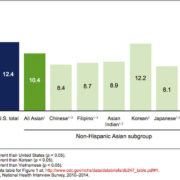A NEW study by the Centers for Disease Control and Prevention (CDC) has found that Asian adults – particularly Chinese adults – are physically and psychologically healthier than other US adults.
Overall, Chinese adults reported better health in five measures included in the report: likelihood for fair or poor health, chronic conditions, psychological distress, work limitations and limited social participation.
The study, based on data from the 2010-2014 National Health Interview Survey (NHIS), took into account the six largest Asian subgroups: Chinese, Filipino, Asian Indian, Japanese, Vietnamese and Korean.
For other groups, no clear patterns were observed for the measures.
Filipino adults fared better than all US adults in the five measures, although the group was nearly equal to US adults when it came to a likelihood of having multiple chronic conditions, posting 22.3 percent compared to 24.1 percent. Filipino adults also came close to all US adults in the measure of likelihood for limited social participation at 3 percent compared to 3.9 percent.
Asian Indian (4.1 percent) and Korean adults (4.6 percent) were more likely than US adults to have limited social participation.
Vietnamese adults were the most likely group to report fair or poor health status (16.8 percent), surpassing the total for US adults (12.4 percent); Japanese adults were the most likely to report a work limitation (4.1 percent).
“The findings of this study are consistent with these earlier analyses on non-Hispanic Asian subgroups and add to the body of evidence concerning their widely varying health,” wrote authors Barbara Bloom and Lindsey Black, who are with the National Center for Health Statistics Division of Health Interview Statistics. “Further research is needed to better understand the differences among subgroups in health care and health care outcomes for this population.”
Asians constitute 5 percent – or 15 million people – of the US population.
The data used in the report was collected on more than 165,000 adults aged 18 and older. Noted by the authors is that less than 1 percent of NHIS interviews are conducted in languages other than English or Spanish. In these cases, a family member typically translates for the respondent.
In the data collected from 2010 to 2014, approximately 8 percent of interviews were conducted in other languages for non-Hispanic Asian respondents. Additionally, 16.6 percent of family respondents said the sample adult’s ability to speak English was “not well or not at all,” compared to 6.5 percent for all US adults.
“This limitation should be considered when interpreting results in this report,” Bloom and Black wrote.
Not detailed in the report are the reasons for Asians’ better health in these areas, nor the genetic risk Asians face for developing diabetes, which is the seventh most common cause of death worldwide.
In LA County, 10 percent of Asian Americans are diabetic, compared with 7 percent of whites, despite Asian Americans’ lower obesity level, the Tribune News Service reported.
Scientists believe the mismatch is because obesity measures weight – not necessarily fat, which is what is associated with diabetes.
South Asians have some of the diabetes rates among Asians, according to the Tribune News Service.






